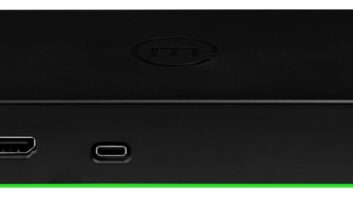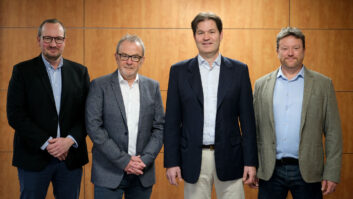The high-definition optical disc format war is expected to build in intensity at International CES following recent pre-holiday Blu-ray Disc (BD) player introductions and the introduction here of a third second-generation HD DVD player model from Toshiba.
HD DVD and BD supporters will rally their respective troops here to start building sales momentum among the legions of new and established HDTV set owners who can maximize the benefits of the new technologies.
Andy Parsons, Pioneer senior VP and Blu-ray Disc Association promotion committee chairman, cited Jupiter Research forecasts showing 96 percent of U.S. homes with digital TV broadcast tuning by 2010, up from 36 percent in 2006, as the target audience for BD players.
In 2007, HD DVD format developer Toshiba is targeting HDTV penetration of between 45 million and 46 million households.
“By the end of 2007 we expect HDTV to reach a household penetration level of between 25 and 26 percent,” said Jodi Sally, Toshiba A/V products marketing VP. “For 2007, on a cumulative basis, Toshiba expects HDTV penetration to hit 45 to 46 million households.”
For 2006 the combined U.S. market for HD DVD and Blu-ray Disc players, excluding gaming consoles and PC devices, was estimated to have hit approximately 350,000 units, according to Sally. In 2007, that is expected to grow to between 2.9 million and 3.5 million units, she said.
“If we attach HD DVD to just 8 percent of those homes, that could be a 3.5 million unit market for next-generation optical discs, and that’s how we’re planning our market estimates,” Sally said.
Recent announcements from NEC and Broadcom of integrated chips supporting both formats have raised speculation that inexpensive universal players are just around the corner.
But manufacturers said the need for dual pickups to read both formats in addition to a supporting backend would essentially double the production cost of such players.
“This is not like recordable DVD,” said Parsons. “It’s a packaged publishing medium, and in terms of content being published — that’s a whole different environment.”
He continued: “We’ve been criticized for not blending the two formats together, but that would have meant giving up [the added capacity] that we worked so hard to achieve — the physical construction of the disc itself — and that’s not something we were willing to budge on.”
For now it appears it’s a battle to the death, and HD DVD has the early lead. But with more supporting manufacturers and Hollywood studios, the Blu-ray camp says it has HD DVD out gunned, and victory may not be far off.
Toshiba’s initial HD DVD models, which launched in April 2006, sold well in the first year, Sally said, adding that the company could have sold more if it had more supply.
Reviews for HD DVD image and picture quality were generally very good, but the first-generation Toshiba players were criticized for difficult-to-use remotes and slow disc startup times.
Both negatives were corrected in the release of second-generation players that arrived in stores prior to the holidays, according to Sally. Toshiba is also adding a third model to the middle of its assortment at CES. The HD-A20 ($599 suggested retail) will support 1,080p output over HDMI/HDCP.
“HD DVD delivered on everything we said it was going to deliver on,” Sally declared. “Our advanced HD codecs, including VC-1, got great reviews. Dolby Digital Plus, Dolby TruHD and DTS HD were also mandatory audio codecs for HD DVD, where as with Blu-ray Disc those are optional.”
Perhaps the biggest advantage was the comparatively low entry cost for an HD DVD player, with Toshiba’s opening price point at $499. In comparison, Samsung’s Blu-ray player sold for $999, while Sony’s opening price point PlayStation3 model started at $599.
The BD folks remain confident, adding that Toshiba is losing money on every player it sells.
“It’s not like we have a horse race that is neck and neck,” said Parsons. “The HD DVD guys are doing a very good job, but we are going to surpass them pretty quickly here, and when that happens it is going to be clear which format’s going to dominate.”
Parsons touts BD’s strength in having seven out of the top eight Hollywood studios backing the format as a major advantage. Similarly, it has the numbers in player manufacturers.
As of the fourth quarter of 2006, the BD camp listed BD players shipping from five brands including Samsung, Panasonic, Philips, Pioneer and Sony, plus Sony’s hot PS3 gaming console, which in addition to advanced gaming and networking, fully supports the BD movie format with HD resolution output including 1,080p.
The BD camp is calling PS3 its “800-pound gorilla” in the format battle, citing the rapid adoption of the DVD format soon after the PS2 arrived.
“When you consider the brand presence of everyone supporting BD players and realize that most of them also sell HDTVs, you can start see the impact the consumer is going to feel on the retail floor,” Parsons said.
Still, the HD DVD camp was aided last fall by the delivery of an HD DVD add-on drive for Microsoft’s popular Xbox 360 video game console, supporting HD DVD movie playback.
As for HD DVD’s much-touted price advantage, the BD camp isn’t flinching.
“We are in the early stages of a launch, and most companies realize that a new technology like this doesn’t start out in the mainstream — it begins in the early adopter community, and those are people who are not so focused on pricing. You can price your player at $499 if you want to, but no one is going to be making any money at that price.”
As for the much touted software advantage, HD DVD offered 150 titles by the end of 2006, with new releases issued every Tuesday.
Recent studios announcing support for HD DVD included the Weinstein Company and Image Entertainment, Genius Products, Rhino Records, HDNet and DVD International. Major studio support includes Universal Studios (exclusive to HD DVD so far), Paramount, Warner Bros. and most of its affiliated studios.
Going into the 2006 holidays, 1.6 million HD DVD discs had been shipped to retailers. Toshiba estimates that on an annualized basis an HD DVD customer will purchase between 25 and 30 HD DVD movies.
The BD camp said it had over 100 BD video titles in the market after just five months. “With seven studios churning out titles every week it won’t be long before we surpass HD DVD in the number of titles available,” Parsons declared. “With DVD it took nine months just to get all the studios to sign up for the format.”
Blu-ray supporting studios include: Buena Vista Home Entertainment, Fox, Lionsgate, MGM and Sony Pictures (all exclusive to BD so far) along with Paramount and Warner Brothers.
Meanwhile, BD is not without its knocks. Some early BD titles have been criticized by retailers and enthusiasts for less-than-spectacular picture quality, a condition some blamed on a few studios using 25GB single layer discs combined with MPEG-2 codecs, requiring lower bit rates.
“I don’t think I buy that,” Parsons said, adding that in some cases criticized BD movies may have been displayed on sub-high-definition displays, offered content with a lot of natural film grain or involved comparisons using different HD titles.”
“We’ve been able to demonstrate that all three codecs do a spectacular job,” Parsons said. He added that many of the blog sites that were initially critical of BD are now softening.
Three disc media types are now available in BD including, read-only media, writeable and rewriteable. In addition dual-layer 50GB BD-ROM discs are now being mass produced with 16 BD-50 movie titles either planned or already in distribution, while BD backers point out that HD DVD’s purported triple-layer format has yet to receive DVD Forum approval.
“Studios are using the BD-50 disc as needed when they have some additional content or the film is very long,” Parsons said.
One of those BD-50 titles — Lionsgate’s “The Descent” — uses the VC-1 codec and adds more extra content and features than most titles available on BD-25 discs.
“I think we all will start to take advantage of many special extras, including picture in picture [for audio and video running commentaries] and seamless branching [the ability to shift between multiple endings when the movie is in progress] now that the 50GB disc is available,” said Ron Schwartz, Lionsgate Home Entertainment executive VP and general manager.













